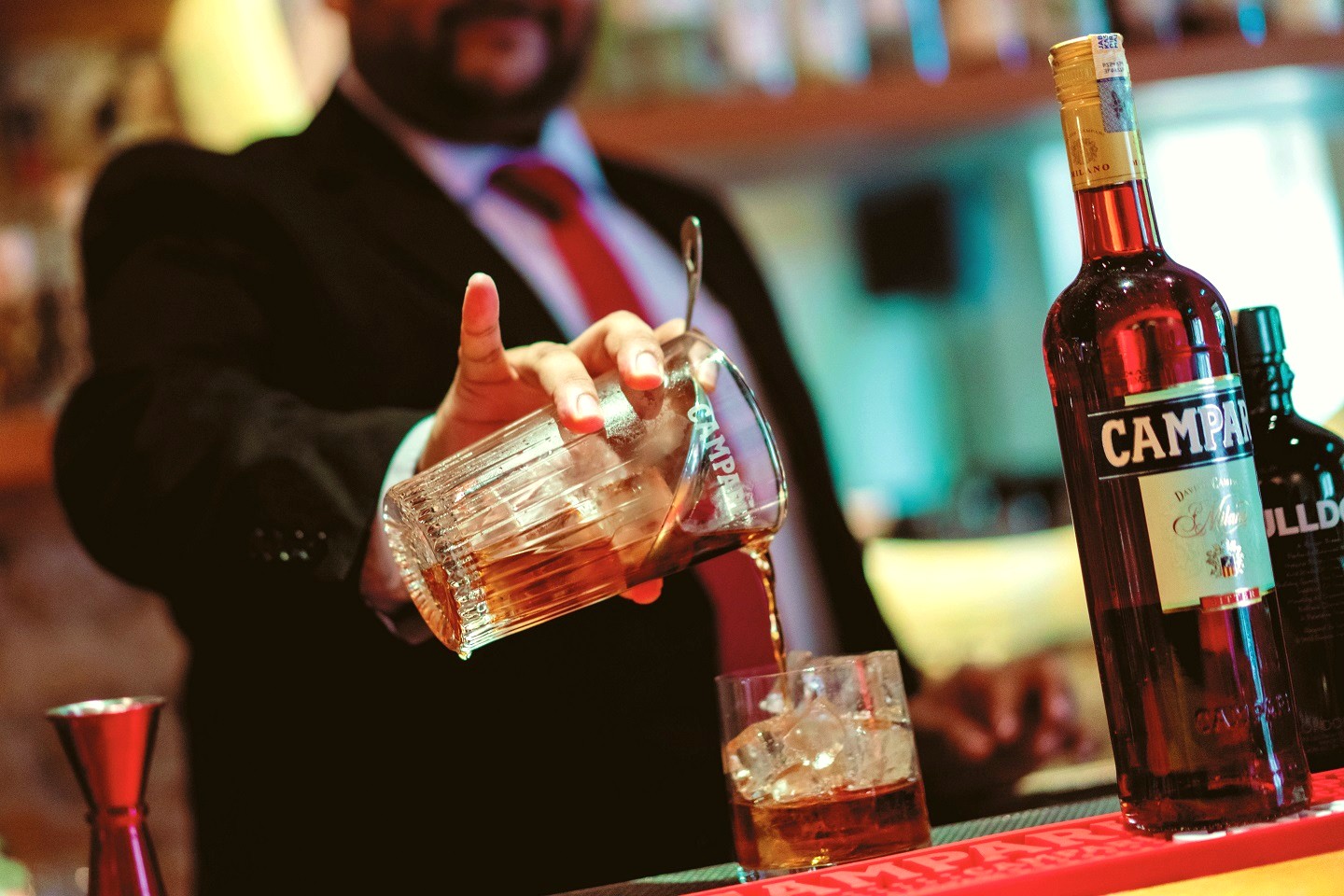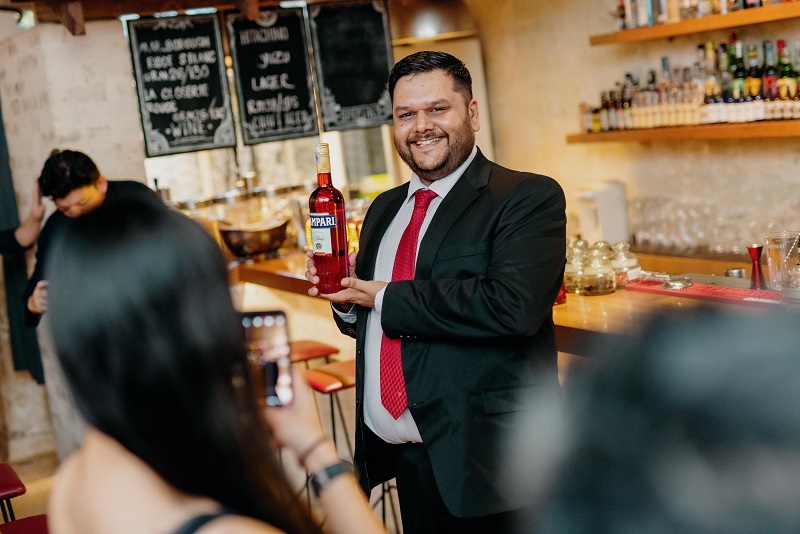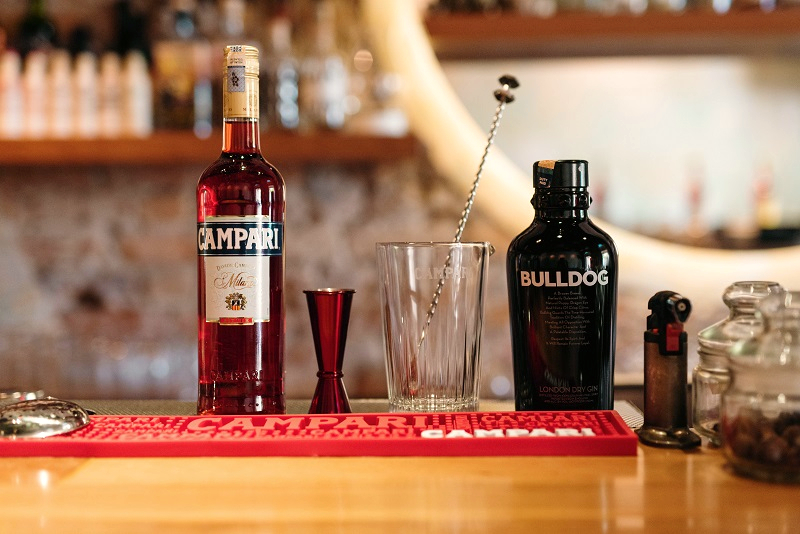
Divyesh Chauhan whips up a batch of Negroni using equal parts Campari, Bulldog gin and Cinzano 1757 vermouth (All photos: Campari)
Classics are so named for their ability to endure, a quality only revealed over time. But in the case of cocktails, there is another trait that lends itself to potential longevity: minimalism.
“Most classic cocktails are made of three ingredients or less,” says Divyesh Chauhan, regional brown spirits ambassador of Campari Group and co-owner and co-founder of rum bar JungleBird KL. He cites the daiquiri, martini and Old Fashioned as examples, stating that their simplicity enables them to act as canvases for creative twists and interpretations.

We are at Pahit in KL, one of the bars partaking in international charity initiative Negroni Week. Traditionally composed of equal parts Campari, gin and vermouth, the classic cocktail became the titular force behind the weeklong event, launched in 2013 by Imbibe Magazine and Italian aperitif Campari to place the power of fundraising in the hands of bartenders and consumers around the world. The original participation of about 100 bars had snowballed to nearly 10,000 venues in 87 countries last year with a total of almost RM8 million raised in five years. Funds collected are donated to various causes that differ from country to country.
In Malaysia, an initial participation fee paid by all bars this year was channelled into Water for People, which improves access to high-quality drinking water and sanitation services, while proceeds from the sales of Negroni and each bar’s choice of twists to the classic cocktail will be contributed to Cancer Research Malaysia.
The festivities are extra-special this year as Campari celebrates its centenary. Its story is a tale of exceptional endurance, considering the aperitif originated in the northwestern province of Italy’s Novara in 1860 and its recipe remains a family secret until today. This means it has no feasible rivals, Chauhan later shares of this infusion of bitter herbs, aromatic plants and fruit in alcohol and water. Vibrant red with an intense aroma and flavour, it is the base for some of the most famous cocktails in the world, particularly the Negroni.
As the story goes, the classic cocktail was inadvertently created in 1919 when Count Camillo Negroni ordered a drink with a twist at the Caffè Casoni bar (now known as Caffè Giacosa, or sometimes Caffè Roberto Cavalli as the designer owns a store next door) in Florence. He asked bartender Fosco Scarselli for an Americano (Campari, sweet red vermouth and club soda) but requested that the soda be substituted with gin, inspired by his last trip to London and its prevalent gin scene. The bartender acquiesced, replacing the lemon wedge with a complementary orange garnish, and the order became the Count’s usual, acquiring his surname as a reference.

Claims contesting the origins of the Negroni have risen over the decades. Count Negroni has sometimes been described as a gambler, cowboy and fencing instructor with little proof of any of these … but there was no Count Camillo Negroni, some say, while others assert the cocktail was not even created in the European continent, but in Africa by a Count Pascal Olivier Negroni who was supposedly posted there. Genealogy reports have been produced and pored over, augmented with birth and death certificates, family trees, photos and statements. Conclusions have been published as definitive, then countered.
While the one true narrative might never be proved, the origins of the cocktail have little implications to consumers, apart from being an interesting titbit to pull out at the bar. What does matter is what is in the glass, and the Negroni is a versatile canvas that is easy to riff off with variations aplenty.
Replace the gin with bourbon and you get the Boulevardier; use rye whisky and replace sweet vermouth with dry to get the Old Pal. Dashes of orange bitters and tequila instead of gin produce the Agavoni. Sbagliato, which means mistaken or messed up in Italian, was the result of a happy accident when a busy bartender reached for sparkling wine instead of the white spirit. Google “Negroni variations” and at least a dozen interpretations pop up.

At Pahit, Chauhan mixes a large batch of Negroni using Campari, Cinzano 1757 vermouth and Bulldog gin. I opt for the sweet and bitter Boulevardier made with Wild Turkey and served over ice with a wedge of fresh orange.
“I enjoy Campari in many expressions, including the Jungle Bird, but I drink Americanos a lot when I know I’m going to hit a lot of bars because of its low ABV,” Chauhan says. “Bitter drinks like Negroni make great aperitifs as they open up the palate, so they’re best enjoyed when the sun is going down. Boulevardier, on the other hand, might be better after dinner because of the whisky.”
Negroni Week, hosted by Remy Cointreau until June 30, is an ideal time to sample these, knowing you will be raising your glass to a good cause. Participating bars include Bar Trigona, Birch, Gin Rik Sha, Omakase + Appreciate and Soma Cocktail Bar around KL; HYDE at 53M, Iki Ya and Mrs Jones Parlour in Petaling Jaya; and Seven Skulls, The 12 Senses and Copper Bar & Restaurant in George Town, Penang. Find the complete list here.
This article first appeared on June 24, 2019 in The Edge Malaysia.


